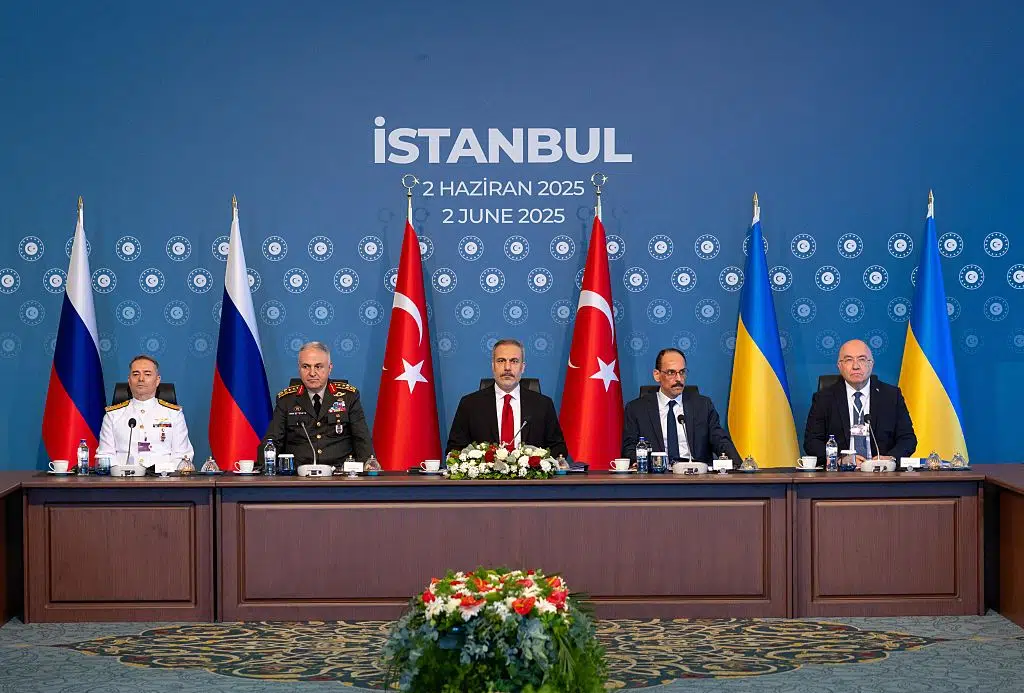Ukraine Peace Talks Stalled: On Monday, June 2, 2025, Ukraine peace talks were held in Istanbul, marking only the second round since 2022. Russia presented a memorandum demanding large territorial concessions and strict military limits. Ukraine refused, calling the terms unacceptable.
The discussions lasted under an hour and ended without a ceasefire. Instead, both sides agreed to exchange prisoners and return soldiers’ bodies. Turkish President Erdogan hosted the event and hopes for a future meeting with Putin, Zelenskyy, and Trump. However, no breakthrough was made, and tensions remained high on both sides of the conflict.
Also Read | Ukraine-Russia Peace Talks Resume in Istanbul: Key Updates and Hopes for Ceasefire
Ukraine Peace Talks Stalled: Insights
- Russia wants Ukraine to give up land and limit its army.
- Talks lasted less than an hour with no agreement on a ceasefire.
- Ukraine proposed more meetings and a list of abducted children.
- Russia agreed to return only 10 of 400 missing Ukrainian children.
- A prisoner swap was agreed, focusing on the youngest and most injured.
- Erdogan hopes to host future talks involving Trump.
- Ukraine launched drone strikes on Russian bomber bases before the talks.
- Western countries were not informed about the attack in advance.
Background
The Ukraine peace talks come after two years of intense fighting. Russia invaded Ukraine in 2022 and has since annexed parts of the country. Earlier peace attempts failed due to strict demands from Moscow. Ukraine seeks full sovereignty, while Russia insists on recognition of its territorial claims.
The conflict has drawn global attention, with the U.S., Europe, and NATO backing Ukraine. The current round was prompted by global calls, including from Donald Trump, to end the war. Yet, both sides remain far apart on key issues.
Main Event
At the meeting in Istanbul, Russia presented its terms for peace. These included Ukraine giving up Crimea and four other regions. Ukraine would also have to become neutral and stop seeking NATO membership. Additionally, Russia demanded official language rights for Russian speakers and legal changes.
Moscow’s proposal outlined two ceasefire options. The first called for Ukraine to leave several regions. The second demanded that Ukraine stop receiving military aid and hold elections within 100 days. Ukraine firmly rejected these proposals.
Defense Minister Rustem Umerov led Ukraine’s team and said the document would be reviewed. President Zelenskyy said only direct talks with Putin could resolve the conflict. Ukraine also submitted a list of 400 children reportedly abducted. Russia agreed to return just 10.
Despite the failure to reach a deal, both countries agreed to a prisoner exchange and to return the bodies of 12,000 soldiers. Erdogan praised the meeting but stressed the need for more action. Trump warned the U.S. that it may step back if progress stalls. The situation remains tense, and the path to peace looks difficult.
Implications
The failed Ukraine peace talks mean continued hardship for both countries. Civilians face danger, economic struggles, and displacement. Ukraine’s military must stay alert as Russia advances on the battlefield. The international community remains concerned about rising nuclear risks.
Western nations are cautious, especially after Ukraine’s surprise drone attacks on Russian bombers. With no clear end in sight, pressure mounts on leaders to find a solution. The absence of compromise could worsen the war and affect global peace efforts.

Turkish Foreign Minister Hakan Fidan (center) leads peace negotiations between Ukrainian and Russian delegates at Istanbul’s Çırağan Palace on June 2, 2025, in this photo released by Turkey’s Foreign Ministry.
Photo Credits: Getty Imgaes.
Conclusion
The recent Ukraine peace talks show how far apart both sides remain. Russia refuses to back down, while Ukraine will not surrender. Despite global pressure, a real peace deal seems far off. Erdogan and Trump may try to mediate further.
However, unless Putin and Zelenskyy meet directly, hopes for ending the war remain low. The coming weeks will be crucial as the world watches closely for signs of progress or more conflict.



